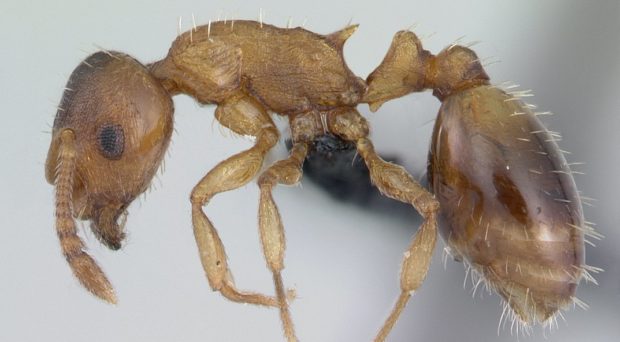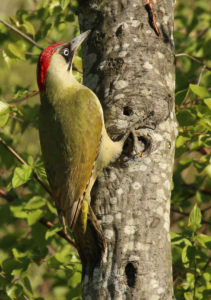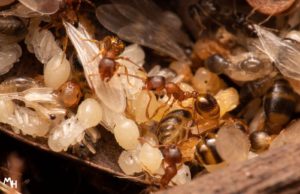
Temnothorax nylanderi, is a tiny species of ant found in woodlands in Western Europe. Colonies are bark dwelling or found in the leaf litter in small cavities such as inside twigs or acorns. Intercaste ants, with characteristics of both workers and queens, are common and increase in number if the colony has been infected with the larvae of the tapeworm, Anomotaenia brevis.
Anomotaenia brevis
As an adult, this tapeworm lives in the gut of a woodpecker. If its eggs, shed with the bird’s faeces, are picked up by T. nylanderi forager ants and fed to the colonies’s larvae, then the life cycle continues. The parasites hatch, burrow through the larva’s gut, and develop in the body cavity. The tapeworm’s life cycle is completed if an infected ant is eaten by another woodpecker.

On the face of it, transmission from woodpecker to ant and back again seems unlikely. However, in common with other parasites with complex lifecycles, these intermediate host experience changes in life history traits that could improve the likelihood of transmission occurring.
Sarah Beros and colleagues from Johannes Gutenberg University of Mainz have been looking at the effect of this tapeworm infection on the life history traits of these wood ants and have published a series of papers reporting their findings. Infected workers exhibit morphological changes and can develop ovaries in the absence of a queen. These parasitised ants are tolerated by their nest-mates, despite being chemically distinct from unparasitised workers, and, more than that, they are fed more often.
In 2015 the group reported that the presence of infected individuals in a colony had a profound effect on all the workers in the colony. In a parasitised nest, uninfected workers became less aggressive and exhibited a decrease in longevity whereas infected ants showed reduced flight response, and do not take part in foraging as they age and survived longer. I discussed these findings in a BugBitten blog in 2015.
This research group have recently reported further findings showing the long reach of this tapeworm into the life of the whole colony.
The new investigations: survivorship
Over a period of three years, newly hatched (calows), nurses (young worker ants undertaking brood care), foragers and queens from parasitised and unparasitised colonies (57 in total) were observed in the laboratory. Infected ants could be recognised by their unpigmented cuticles.
A few individuals from each colony were marked with wire and their survival monitored. By the end of three years 21% of the colonies were dead. In the surviving parasitised colonies, all the marked unparasitised workers were dead, whereas just over half of the parasitised ones survived. None of the nurses and only 2% of the marked foragers survived in the unparasitized colonies. This confirmed the remarkable extension in life span that resulted from infection.
Metabolic rate and other comparisons
Investigating 14 parasitised and 14 unparasitised new colonies, the researchers found that queens had the lowest metabolic rate and unparasitised foragers the highest. Infected workers had similar metabolic rates to nurses, i.e. between queens and foragers. Unsurprisingly, queens had a much greater body mass than all other ants and, in this case, there was no difference in body mass between parasitised workers and unparasitized nurses and foragers.
Unparasitised nurses had by far the highest lipid content whereas the lipid content of parasitised workers fell between that of foragers and queens.

In unparasitized colonies, the queen received more social care than nurses, and nurses more care than foragers. But in parasitised colonies the infected workers received even more care than the queens.
This added attention is likely to be related to chemical cues emanating from the infected workers, as was shown by measurement of responses of nestmates to glass beads coated with cuticular hydrocarbons, given off by parasitised or unparasitized brood-caring workers. More attention was paid to cuticular hydrocarbons from parasitised nest-mates than unparasitized ones. It is unclear whether this is caused by a change in one specific hydrocarbon or the general profile, or how this change is achieved.
Longevity in perspective
The remarkable increase in longevity seen in infected workers is by no means an uncommon result of parasitisation. For instance, work from my lab demonstrated a highly significant increase in the longevity of beetles infected with rat tapeworm larvae. This effect was accompanied by a reduction in fecundity, suggesting a resource trade-off was occurring. However, this is not the case in this woodpecker tapeworm / ant association. Previous work from the group has shown that, if the queen is removed from a parasitised colony, the parasitised workers respond most rapidly by developing ovaries.
Instead, could their increased longevity be due to the extra care parasitised workers receive, possibly at the expense of their unparasitized nest-mates?
Is increased host longevity a benefit to the parasite?
The tapeworm will only complete its lifecycle if an infected ant is eaten by a woodpecker. The authors of this fascinating series of papers point out that these tiny ants, foraging in the leaf litter, would be difficult to find. Woodpeckers are more likely to successfully predate the ants by searching for their nests. Both the altered behaviour that keeps parasitised ants in the nest, rather than foraging, and their extended lifespan is thus likely to increase the chance they are predated and Anomotaenia brevis completes its lifecycle.

Comments